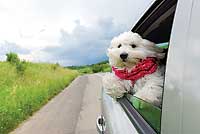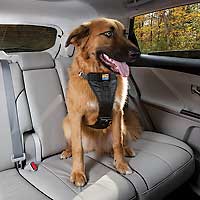We bring our dogs everywhere, if we’re hiking, they’re trekking with us. We’ve figured out all of the dog friendly stores and spots in town, and we wouldn’t consider a road trip without our trusty canine co-pilot. Nose prints on the windows are a sure sign of an excellent journey, or are they? Cars are designed to keep humans safe, but at what cost to our canine companions. Distractions behind the wheel contribute to thousands of accidents per year. In addition to texting, adjusting radio dials, and eating, a loose dog in a vehicle can be a dangerous distraction. 
Additionally, an unsecured dog can become a projectile in the event of an accident or sudden stop. In a car crash at 35 miles per hour, an unrestrained 60-pound dog becomes a 2700-pound projectile, which can cause serious injury or death to your dog and passengers in your car. Yet many of us drive around every day with our dogs just sitting on the front seat, back seat, truck bed or even our laps. Preventing your canine companion from distracting you while on the road and keeping them safe for the drive can be as simple as using a restraint system harness or securing your dog in a crate while in a vehicle.
Securing your dog in your vehicle is like buying a fire extinguisher, most of us don’t plan on testing a dog safety harness, but if you ever do, it becomes evident that having your dog restrained in your vehicle is a good thing. Throughout recent years, several states have considered legislation to make dog seat belts mandatory. New Jersey made headlines in 2012 when a proposed law called for seat belts for dogs, a move that elicited strongly worded responses from those critical of the requirement. Other states have likewise proposed dog seat belt laws, Maine, New York, and Rhode Island among them. These dog safety belt requirements have been met with varying degrees of success, usually in the form of restricting dogs to the back seat of the car but not actually mandating a restraint system.
As of August 2018, only a handful of states had specific laws requiring a dog to wear a car harness or be otherwise restricted in a moving vehicle. Many states have passed laws banning dogs from the front seat, truck bed, or from hanging their head out the window. Some states, including Arizona, Hawaii, and Connecticut may charge drivers under distracted driving laws if they drive with a dog in their lap. Similarly, drivers in Los Angeles may be ticketed for driving at an unsafe speed if they’re caught with a dog in their lap; the LAPD states that no speed is safe with a pet in your lap.
Three main thigs you need to consider for keeping your dog safe when driving are preventing distractions, managing your dog’s deceleration rate upon impact, and keeping your dog restrained post-crash, All of that needs to be achieved with speed and convenience if you are actually going to bother using a restraint system every time you load your dog in to your car. In addition, the system needs to be comfortable for your dog.
Researching for this article, I was unaware of the importance of making sure a dog is restrained in the aftermath of an accident. But it makes sense. In the event of an accident dogs can panic and flee accidents through a broken window or open door, only to be lost or hit by oncoming traffic. Sometimes a panicked dog could delay treatment for an incapacitated owner, with a rattled dog some emergency responders say that they can’t get access to the human because the dog will not let them get close.
The easiest way to secure your dog in a car is with a divider between the front and back seat or between the back seat and load area of a wagon or SUV. Load your dog into the back of the car, and they are contained in a safe area, away from the human occupants. Not all dividers are created equally. Many dividers are mesh material and install using plastic clips attached to the front seats, load dividers install only under tension and are built from flimsy materials. It is recommended that you look for a divider that bolts to the frame of the car, if you can rip the divider out with your hands; it is probably not going to sustain an impact. To find these types of dividers you do quite often have to purchase directly from your vehicle maker as they are specific to the dimensions to the make and model of your vehicle.
A crate takes containment of your dog in a vehicle one step further and would work even if the rear window gets broken in an event like a rollover. Many dog owners choose crating as a relatively safe car restraint option. This can be an excellent choice, and it does have drawbacks. To be super-safe, the crate needs to be fastened securely in the back of the vehicle. Space is another consideration. Crates require a lot of room and in order to provide an appropriate amount of safety for your dog, their crate needs to be able to fit snugly in your vehicle. If you have a mini-car and a maxi-dog, there’s no room for a crate, you need to explore other options for restraining your dog in your vehicle.
One of the most important things you can do before buying a dog crate for your car is to measure your dog. This is something that many owners miss and it is a crucial step to make sure that your dog is the right size for the crate. You can measure from the tip of your dog’s nose to the base of their tail, from the base of their feet to the top of their head to make sure they have enough room to move around and be comfortable. When choosing a crate you need to consider the material it is made from. Metal is usually the best material for crates, soft sided crates are good for smaller dogs or short drives, plastic crates need to be made of tough plastic with metal doors. If you are strapping something down that is supposed to take a 2700 pound hit, but it is made from plastic you can break with a kick from your foot, it is probably not going to hold up in a crash.
The first thing you probably do when you get in the car is put your seat belt on, and any kids in your life are likely to have a safe and secure car seat, but what about your dog? Securing your dog in the car is important for their safety, your safety, and the safety of other drivers so it’s vital you choose the right product to do this. A dog car harness not only tethers your canine companion securely, but lessens the chance of their injury should you get into a collision.
Aside from being crash test certified, you will want to look for a few additional characteristics and features when selecting a good dog harness for your car. The most important considerations include looking for a harness that are easy to adjust, a proper fit is imperative for safety, so you will want to select a harness that provides several places for adjustment, this will ensure your dog fits well in the harness, no matter their size or shape. Look for harnesses that have dual functionality, some of the best car harnesses are easy to take out of the car, allowing them to be used as a normal harness, like the Enhanced Strength True Fit Car Harness available at the Moab Barkery.
Whatever method you choose for restraining your dog in your vehicle, restraint is the best solution for keeping your dog safe and you focused on the road ahead. You are keeping your dog from rattling around inside your car, going out the windshield or in the event of a rollover where the windows break out, the dog is restrained and not running away. We build cars for people, until someone designs a car with dog safety in mind and you want to keep your dog safe in your car, a harness is your best option.
Tip from the
Humane Society of Moab Valley |
Traveling with Your Pet in Canyon Country:
Practice Water Safety - Just because your dog loves the water doesn’t mean he always knows its dangers! Keep an eye on your pet around water, especially when it’s an unfamiliar place. Animals won’t know about fast-moving currents, how tired they can get if they swim out too far (or for too long), and potentially-poisonous water sources, among other things. If your pet will be in and out of water often on your trip, bring along a life-jacket for him or her, too. |
|